The 1959 Cadillac
Cyclone

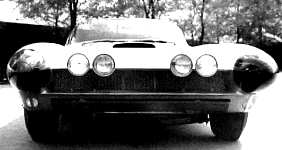
Nose cones and flip-up headlights
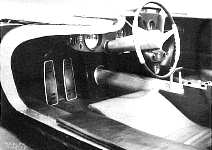 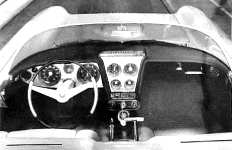
The rare B&W photos (immediately above) are from
the Cadillac Styling Studio archives; they are reproduced here,
courtesy of GM/Cadillac and Floyd Joliet who enabled me (and my camera) to access that
"shrine" in the Fall of 1994;
the photo (left) is a seating buck; it is dated Nov. 28, 1958; the one on the right
is dated Oct. 27, 1959
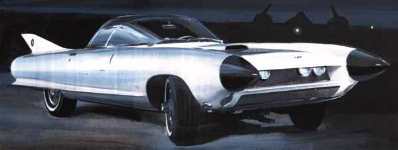
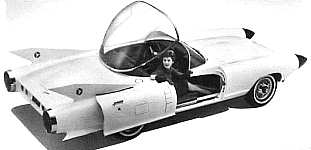 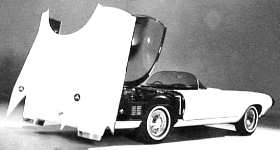
The Cadillac Cyclone
with the original white paint and the GM Air Transport logo on its towering fins;
RH photo shows bubbletop being retracted into rear compartment, where it rested on a
special air bag
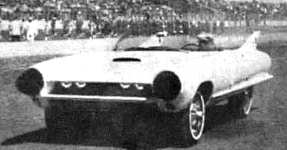
First public appearance, Daytona Beach, February 21,
1959
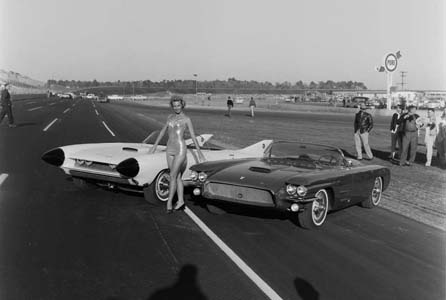
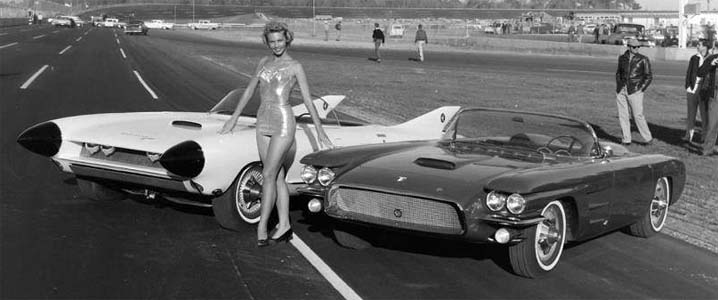
This photo (and enlargement):
Internet, 2015
This car was first shown on 21.2.1959 at Daytona
Beach race track in Florida (above photo), where it was plagued with various malfunctions;
the car was actually never finished, owing to Harley Earl's retirement. The engine
was a standard Cadillac 390 ci, rated at 325HP; brakes were power-assisted through the
reserve tank of the air-suspension unit; there was a two-speed rear axle to allow a choice
of six speeds through the standard 3-speed Hydra-Matic [it is not certain that this was
ever hooked up, but the T-handle in the cockpit shows the positions
"P,N,6,5,4,3,2,1,R"]; muffler and exhaust outlets were placed ahead of the front
wheel openings. The car had 4 retractable headlights; front cones masked radar devices
allowing the car to steer itself thanks to a tracking sensor placed under the front of the
car that could follow a signal from a wire imbedded in the road; a test loop was set up at
proving grounds to show the effectiveness of the system. A proximity warning device was
supposed to prevent collisions but it was never tested in practice. The car had small
openings cut in the doors for passing various materials in and out; there was a sound
system to the outside world, through speakers located behind grilles in the front fenders,
for use when the canopy was raised. This was a fair-weather car, not really designed for
use with the top up, which made entry and egress very difficult. Its principal features
were a bubbly top canopy and doors that popped out at the touch of a button, then could be
slid back (a system popularized by Volkswagen on its minibus series around the same time).
Built on a 104" chassis, the Cyclone is 197" long and stands only
44" tall; the body is made of steel (not fiberglass, like some experimental models);
power is provided by the standard 325 HP engine fitted with a low-profile carburetor, a
cross-flow aluminum radiator and two fans. The initial white pearlescent paint was
replaced later with silver; at the same time, the GM Air Transport logo disappeared from
the tall fins, to be replaced by an oblong, vertical Cyclone name badge placed at
the extremity of each rear fender. The seats are silver leather.
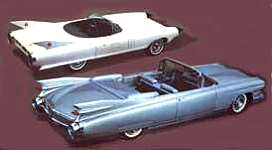 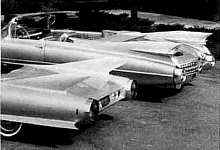
It might be supposed, at first, that the color
photo (left) and the B&W photo (right) were taken during the same photo shoot;
wrong. In the LH (color) photo, the Cyclone carries the GMAT logo on the
inner and outer faces of the tail fins; however, in
the B&W photo (right), the former logo is gone, replaced by a rectangular,
vertical Cyclone name badge, and the car has been
re-sprayed in a metallic hue. In addition, the Eldorado Biarritz in the color shot
has the front bench seat, whereas the one in
the B&W shot has the optional bucket seats, an out-of-place trunk "V"
and crest and regular Series 62 convertible side
trim; although not visible in this small, low resolution image, the interior trim
is that of the regular Eldorado models
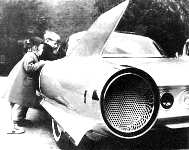 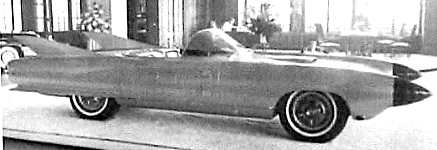
The photo on the left
obviously was taken the same day as the preceding one (above, right) - you can just make
out the
1959 Eldorado's ventipane and rear-view mirror at the far right of the photo; the
gal in the photo is Anne Turnes
who can be seen also seated in the custom 1959 bubble-top limousine (1959
Dream Cars section - the two-tone shoes
and bobbed hair-do are a dead giveaway; obviously, therefore, the photos of the Cyclone
and bubble-top limousine were
taken on the same day). Anne is wearing an overcoat so it is probably early in the year.
The photo on the right shows
the modified Cyclone on display in a lavish showroom; a Sixty-Special
sedan is in the background (far left)
The press first referred to the Cyclone
in the afternoon papers on 20 February 1959. They said: DETROIT - Development of the
Cadillac Cyclone, latest in a long series of General Motors experimental cars to
test new styling and engineering ideas, was announced today by William L. Mitchell, GM
Vice President in charge of Styling Staff. The two-passenger automobile has a clear
plastic top which folds backwards beneath the surface of the trunk deck. Among its
advanced design and engineering developments is a radar locating device which scans the
highway and warns the driver of objects in his path. The Cyclone will make
its first public appearance tomorrow in Daytona, Florida, where a week of automotive
events is concluding. Driving the new car will be Harley J. Earl, who retired as GM Vice
President in charge of Styling on December 1, 1958. Mr. Earl is now consultant to GM. The
car is pearlescent white with a steel blue interior. Its overall length is 196.9 inches
and wheel base is 104 inches. Its overall height is 44 inches at the top of the passenger
canopy. The body is of steel. Distinctively Cadillac in styling with sweeping lines
culminating in traditional Cadillac tail fins, the car was developed by GM Styling in
cooperation with Cadillac Motor and a number of other GM divisions. Large, twin
nose cones in the front of the car house the proximity sensing units. They electronically
alert the driver with both an audible signal and a warning light of any automobile or
other object which he is approaching. The pitch of the signal increases as he draws closer
to the object. The one-piece, laminated plastic canopy fits snugly against the
panoramic windshield to give the driver true 360 degree vision. Its top is silver-coated [on
the inside] to deflect the sun's rays. The canopy is hinged at the rear and is power
operated. It lifts to afford easy entrance for the passenger when either door is opened
and disappears automatically beneath the rear deck for storage when not in use.
Cyclone's doors are unusual, also. At a touch of a button on either side. the door
moves outward from the car three inches. The driver then slides the door back along the
side of the car for an easy entrance. The door moves smoothly on ball bearings. A
standard Cadillac 325 horsepower engine is positioned in the nose of the car. It features
a new low-profile carburetor, cross flow aluminum radiator and twin fans. The muffler and
the exhaust system is located in the front engine compartment with the exhaust outlets
just ahead of the front wheels. An experimental Hydra-Matic transmission and final drive
assembly are mounted behind the passenger compartment. Front suspension
incorporates standard 1959 Cadillac air suspension units. The power brake system uses an
air servo instead of the conventional vacuum servo with the air supplied from the air
suspension system. The steering system uses the Saginaw rotary valve power steering gear
with variable ratio added. Front wheels and front brake drums are integral aluminum
castings and feature improved cooling for increased braking power. Rear brakes are mounted
inboard and are of conventional cast iron. The 14-inch wheels are cast aluminum. The
passenger compartment has bucket seats and advanced passenger comforts. Instruments are
clustered like an aircraft dashboard before and between the two passengers. An
intercommunication system allows passengers to converse with persons outside the
automobile without raising the canopy. Combined heating and refrigeration units are
housed in the cowl sections on either side of the passenger compartment doors. Operated by
a single dial, this system provides optimum weather conditioning and defrosting. The Cyclone
will be used as a rolling laboratory to test its new features. It is the 38th experimental
car built by General Motors since the original Y-Job was introduced in 1938. Besides
Cadillac, GM's engineering staff cooperated on the Cyclone project as did the following GM
Divisions: AC Spark Plug, Delco Appliance, Detroit Transmission, Fabricast, Harrison
Radiator and Saginaw Steering. Another write-up appeared in Motor for April,
1959.
The Cyclone was remodeled a couple of times, first after its
initial public showing at Daytona Beach, in February 1959, then again in 1960. First
the GMAT logos were removed from the tail-fins and the car was repainted a metallic color
[I have seen no color photos of that first repaint but assume it was silvery-gray, just as
it looks today]; a small, vertical, rectangular Cyclone nameplate was affixed to
the rear fenders near the tail-light housings. The
tall fins were later drastically cut down [1960] and some redesigning was done to the
wheels and the rear end, including moving the tail lights from the rear panel on either
side of the number plate to the outer, circular housings which previously had simulated
rocket exhaust ports. The problematic air-suspension was replaced with conventional coil
springs (as happened to many air-sprung Cadillacs of 1959 and 1960).
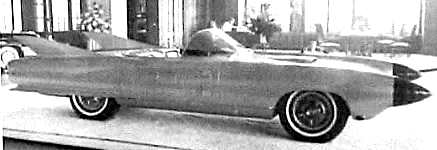
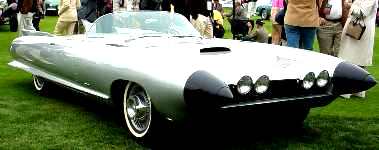 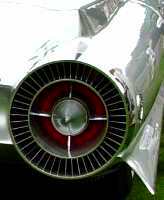
 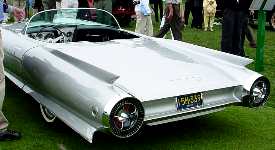
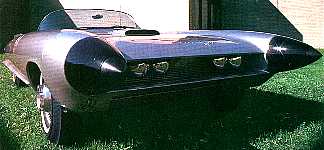
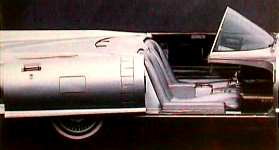
Above three rows: the modified Cyclone with
dramatically reduced tail-fins and remodeled tail-lights
The Cockpit,
Instrumentation and Controls
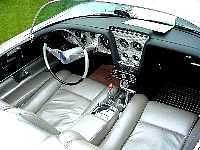 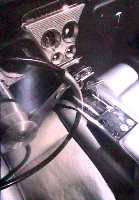 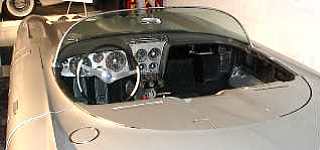

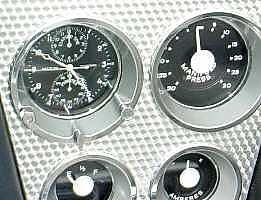 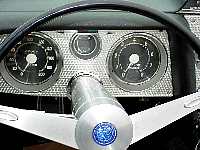 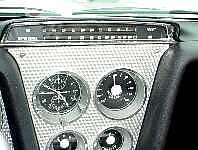
Part of the Cyclone's instrumentation is
located in front of the driver; the reminder of the gauges are mounted
centrally on the dash; in front of the driver are the speedometer (LH), oil gauge
(center) and tachometer (right);
in the center vertical console are a clock-chronometer (at top, left), manifold
pressure gauge (at top, right), fuel gauge
(AT lower (left), ammeter (at lower, right).
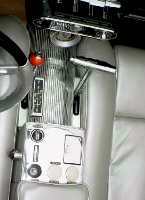 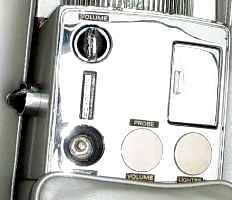
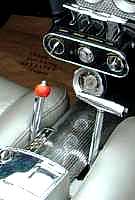 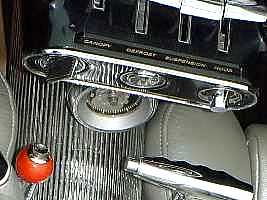 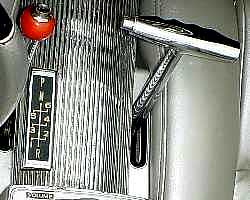
Below the four gauges on the vertical panel are four
"T" levers (center, upper block); from left to right, these are :
the canopy control lever, the defrost lever, the air suspension adjustment lever
and the hood release lever;
below that panel are three more switches: Cruise Control (left), ignition lock
(center) and heater control (right);
to the left of the central console (transmission tunnel) is the hand brake lever
(rd knob); on the right is the T-handled
shift lever for the automatic transmission. Radio controls and ash receiver are
located at the rear of the console
In an article published in France in the late
Eighties it was stated that the "low" fins represented the end of an era and
appeared on some early sixties Cadillac models; in fact the car shown in that article is
the modified Cyclone, with drastically lowered fins; the original 1959 Buck
Roger's-type car had towering fins (taller in fact than those on the 1959 production car)
with GM's Air-Transport Division logo [a stylized white aircraft on a red and blue
background]. These reduced fins and the lower body skeg of the re-modeled Cyclone
appeared in modified form on the 1961 Cadillac models. The tall fins were shaved
down in 1960 so that they did not exceed in height the front fenders. At that time
too, new wheels were added; these are dished, like the standard 1961 wheel discs but
feature a center cap similar to that used on the 1957-58 Eldorado Brougham.
Tail-lights and reversing lights were removed from the rear panel and incorporated in
the tail-light housings which were appropriately remodeled. The rectangular Cadillac
name badge on the rear fenders was replaced by a new Cadillac wreath and crest; a new,
horizontal name badge was designed for the front fenders. The vacuum chrome coating on the underside of the canopy
had peeled off early in the car's life.
The modified car retains the blue and white
medallion in the center of the steering wheel hub. It depicts St. Christopher (patron
saint of travelers).
Photos of the car as modified in 1960 may be seen
also in the book Voitures de Rêve, by Piccard (published by Edita, Lausanne).
Other photos of this car may be found in SSA94, pp. 14-21; CS12, p.107
[modified 1960], SSA 1980, pp.12-13, CC&CC, 5/1987{***}.
The car is still owned by GM and is shown
regularly at grand auto shows like Meadowbrook, MI, and Pebble Beach, CA. A close-up photo
of the dash (taken at Pebble-Beach in August 2002) shows an odometer reading of 00904
miles, which I can readily believe is accurate, despite the car being (at that time)
43-years-old !

On display once again, this time at the 2013 Amelia Island Concours
d'Elégance in SC
|